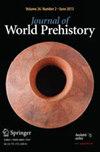From Iberia to the Southern Levant: The Movement of Silver Across the Mediterranean in the Early Iron Age
IF 3.1
1区 历史学
Q1 ANTHROPOLOGY
引用次数: 48
Abstract
The origins of the silver trade across the Mediterranean, and the role of the Phoenicians in this phenomenon, remain contentious. This is partly because of difficulties encountered when trying to assign archaeological silver to its geological sources. Here we present a reanalysis of Iron Age silver hoards in the southern Levant, which demonstrates not only that recycling of silver was widespread in the Early and Late Iron Age, but that the components of this mixed silver originated from the Aegean, Anatolia and the western Mediterranean. An assessment of lead isotope analyses combined with compositional data allows the identification of mixing lines based on gold levels in the silver and the Pb crustal age (or, more loosely, geological age) of the ore from which the silver originated. It is shown that, from as early as the 11th century BC, these mixed silver signatures derive from the Taurus mountains in Anatolia, from Iberia and an unknown source—with Sardinia as an additional possibility—and Laurion in Greece in the Late Iron Age. In contrast to copper, which was deliberately alloyed with silver, gold appears to have been mixed unintentionally, through the melting down of silver objects with gold parts. It is suggested that vertical mixing lines (with constant Pb crustal age but variable Au), may indicate the melting down and mixing of silver in times of unrest, both here and in other contexts. Gold and lead concentrations in the silver indicate that native silver from Iberia was most likely used in the Early Iron Age, suggesting that the first people to convey silver to the southern Levant were not miners but traders who had acquired silver directly from the indigenous Bronze Age inhabitants of Iberia. However, evidence of the exploitation of jarosite also supports that silver ore mining and cupellation was ongoing in Iberia at a similar time, and continued in the Late Iron Age—potentially a result of technological transfer from the East. In essence, the western Mediterranean origin of the silver in these Early Iron Age southern Levantine hoards supports an emerging picture of Mediterranean interactions and trade relations in the increasingly bright Dark Ages (c. 1200–800 BC).从伊比利亚到南黎凡特:铁器时代早期白银穿越地中海的运动
横跨地中海的白银贸易的起源,以及腓尼基人在这一现象中的作用,仍然存在争议。这部分是因为在试图将考古银分配到其地质来源时遇到的困难。在这里,我们对黎凡特南部铁器时代的白银储备进行了重新分析,这不仅表明白银的回收在铁器时代的早期和晚期很普遍,而且这种混合银的成分来自爱琴海、安纳托利亚和西地中海。对铅同位素分析的评估与成分数据相结合,可以根据银中的金含量和产生银的矿石的Pb地壳年龄(或者更宽松地说,地质年龄)确定混合线。研究表明,早在公元前11世纪,这些混合银的印记就来自安纳托利亚的金牛座山脉,来自伊比利亚和一个未知的来源——撒丁岛也有可能——以及铁器时代晚期希腊的劳利翁。与故意与银合金的铜不同,金似乎是在无意中混合的,通过将银物体与金部件熔化。我们认为,垂直混合线(Pb年龄不变,而Au年龄变化)可能表明银在动荡时期的熔化和混合,无论是在这里还是在其他情况下。银中的金和铅浓度表明,来自伊比利亚的本地银最有可能在早期铁器时代被使用,这表明第一批将银运送到黎凡特南部的人不是矿工,而是直接从伊比利亚青铜时代的土著居民那里获得银的商人。然而,黄钾铁矾开采的证据也支持,在同一时期,伊比利亚正在进行银矿开采和制银,并在铁器时代晚期继续进行,这可能是东方技术转移的结果。从本质上讲,这些铁器时代早期黎凡特南部地区的白银起源于地中海西部,这支持了一幅关于日益光明的黑暗时代(公元前1200-800年)地中海互动和贸易关系的新图景。
本文章由计算机程序翻译,如有差异,请以英文原文为准。
求助全文
约1分钟内获得全文
求助全文
来源期刊

Journal of World Prehistory
Multiple-
CiteScore
5.30
自引率
0.00%
发文量
8
期刊介绍:
Aims and scopeJournal of World Prehistory is an international forum for the publication of peer-reviewed, original treatments of the prehistory of an area or larger region. It was founded nearly thirty years ago with the remit of providing researchers, instructors and students with timely and authoritative research syntheses from all fields of archaeology. Journal of World Prehistory continues to lead in this field. Our classic articles may be 20,000 or 25,000 words long, as appropriate (excluding their extensive bibliographies). Since 2008 they have been joined by shorter (around 10,000 words), position pieces, which provide in-depth, thoughtful development of data and concepts, including interventions in controversies that unfold in our pages. These, written in a fashion interesting and accessible to all archaeologists, are often paired with a longer treatment in a single volume. In addition, readers now benefit from thematic special issues and double issues, in which a number of leading authors deal with a key theme in world prehistory, such as the origins of metallurgy (2009, volumes 22: 3 and 4), or the East Asian Neolithic (2013, in preparation). All papers are available first online, followed by the print edition. We aim to be truly global in coverage, with recent articles dealing, inter alia, with Amazonian lithics, the late Jomon of Hokkaido, the Bronze Age in Southeast Asia, the Neanderthal settlement of Doggerland, Neolithic networks in Western Asia, younger Dryas Paleo-Indian adaptations, and state formation in the Horn of Africa. Articles benefit from multi-language abstracts where appropriate, and we work closely with authors who do not have English as a first language to present major syntheses in a clear and concise way to an international audience. Traditionally, JWP focuses on earlier periods, but it includes the beginnings and early development of complex societies, and our understanding of ‘prehistory’ is broad and inclusive: for guidance on chronological scope, as well as our calendrical conventions, see the editorial article ‘Prehistory vs. Archaeology: terms of Engagement’ http://www.springerlink.com/content/346142p032604447/ Our unique remit means that we do not encourage the submission of unsolicited papers; rather, specific proposals are encouraged and then guided prior to independent peer review. Our aims and the way we fulfil them, with close contact with authors throughout the publication process, mean that JWP is not a venue for the simple and rapid dissemination of new results. Whilst we expect scholarship to be current, with syntheses including much new data, our readers look to us for definitive area/period coverage that will have continuing value.If you are proposing an article or special theme for Journal of World Prehistory, please read the Instructions for authors.Rated ''A'' in the European Reference Index for the Humanities (ERIH)?Journal of World Prehistory is rated ''A'' in the ERIH, a new reference index that aims to help evenly access the scientific quality of Humanities research output. For more information visit http://www.esf.org/research-areas/humanities/activities/research-infrastructures.htmlRated ''A'' in the Australian Research Council Humanities and Creative Arts Journal List. For more information, visit: http://www.arc.gov.au/era/journal_list_dev.htm
 求助内容:
求助内容: 应助结果提醒方式:
应助结果提醒方式:


